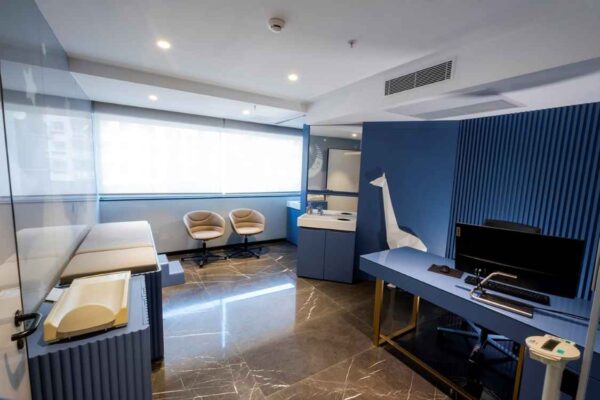Lens implantation, also known as intraocular lens (IOL) implantation, is a surgical procedure in which an artificial lens is implanted inside the eye to replace the natural lens. It is commonly performed during cataract surgery when the natural lens becomes cloudy and affects vision.
The cloudy lens is removed, and the IOL is inserted in its place to restore clear vision. Lens implantation can also be performed for vision correction purposes, such as in refractive lens exchange procedures.
The IOL is chosen based on the individual’s visual needs, and the surgery is typically safe and effective, providing long-lasting vision improvement.
How to Make Lens Implantation?
Lens implantation, specifically during cataract surgery, involves the following steps:
- Pre-operative assessment: Before the surgery, an eye care professional conducts a thorough examination of the eye to determine the appropriate lens implant and assess any potential risks or complications.
- Anesthesia: Local anesthesia is administered to numb the eye, ensuring a pain-free procedure. In some cases, mild sedation may also be provided to keep the patient relaxed and comfortable.
- Incision: A small incision is made in the cornea or the edge of the eye to access the lens capsule.
- Lens removal: The cloudy natural lens, affected by cataracts, is carefully broken up using techniques like phacoemulsification or manual extracapsular extraction. The fragments are then removed from the eye.
- Lens implantation: An intraocular lens (IOL) is inserted into the lens capsule to replace the removed natural lens. The IOL is typically folded or rolled to fit through the small incision and then unfolded or unrolled once inside the eye.
- Positioning and adjustment: The IOL is positioned securely within the lens capsule, ensuring stability and alignment for optimal visual outcome. The surgeon may make any necessary adjustments to achieve proper positioning.
- Incision closure: The incision made in the cornea or the eye’s edge is usually self-sealing, eliminating the need for stitches in most cases. The eye may be protected with a shield or patch for a short period following the procedure.
It’s important to note that lens implantation procedures can vary depending on the specific technique and equipment used by the surgeon. The steps described above provide a general overview of the process, but it’s essential to consult with an eye care professional for detailed information and guidance specific to your individual situation.
How Long Does the Procedure Take?
The duration of a lens implantation procedure, specifically during cataract surgery, can vary depending on several factors. On average, the surgery itself typically takes around 15 to 30 minutes per eye.
However, additional time is required for pre-operative preparations, such as anesthesia administration and patient positioning. Including pre-operative and post-operative activities, the entire process may take a few hours.
It’s important to consult with your eye care professional for a more accurate estimate based on your specific circumstances and the surgical approach used.
What are the Lens Implantation Advantages and Disadvantages?
Lens implantation, specifically during cataract surgery, offers several advantages and disadvantages. Let’s explore each:
Advantages of Lens Implantation:
- Restored vision: Lens implantation replaces the cloudy natural lens with an artificial intraocular lens (IOL), allowing for clear vision. It effectively treats cataracts, improving visual acuity and overall quality of life.
- Permanent solution: Once an IOL is implanted, it remains in place for the long term. There is no need for daily maintenance or removal, providing a permanent solution to vision problems caused by cataracts.
- Visual correction options: Lens implantation provides an opportunity for visual correction beyond cataract treatment. Depending on the IOL chosen, it is possible to address other vision issues, such as astigmatism or presbyopia, reducing or eliminating the need for glasses.
Disadvantages of Lens Implantation:
- Surgical risks: As with any surgery, there are potential risks associated with lens implantation, including infection, bleeding, inflammation, and the possibility of complications during or after the procedure. However, these risks are relatively low, and most surgeries are successful.
- Refractive limitations: While IOLs can correct a range of vision problems, they may not provide the same level of visual acuity as glasses or contact lenses. Some individuals may still require corrective eyewear for specific tasks or activities.
- Intraocular lens selection: Choosing the most suitable IOL requires consideration of various factors, such as visual needs, lifestyle, and the presence of other eye conditions. It is important to discuss these factors with an eye care professional to determine the best option for your specific situation.
It is crucial to consult with an eye care professional who can assess your individual circumstances, explain the advantages and disadvantages, and guide you in making an informed decision regarding lens implantation.
What should be considered after Lens Implantation?
After lens implantation surgery, there are several important considerations for a successful recovery and optimal visual outcomes. Here are some key points to keep in mind:
- Follow the post-operative instructions provided by your ophthalmologist diligently. This may include medication usage, eye care, and activity restrictions.
- Use prescribed eye drops as directed to prevent infection and promote healing.
- Protect your eyes from direct sunlight and dust by wearing sunglasses and avoiding dusty environments.
- Avoid rubbing or putting pressure on your eyes to prevent damage to the implanted lens.
- Attend all scheduled follow-up appointments to monitor your visual progress and address any concerns or complications.
- Practice good hygiene by washing your hands before touching your eyes or applying eye drops.
- Avoid strenuous activities, heavy lifting, and swimming for a specified period as advised by your doctor.
- Avoid using eye makeup or applying any creams or lotions near the eyes until your surgeon gives the go-ahead.
- Inform your healthcare provider if you experience any unusual symptoms, such as severe pain, redness, or vision changes.
- Maintain regular eye exams to ensure long-term eye health and monitor the function of the implanted lens.
FAQs
The local currency of the Republic of Turkey is the Turkish Lira. Our patients can convert their cash from exchange offices to Turkish Lira.
Our patients can withdraw money in Turkish Lira, Euro and Dollar through ATMs in Turkey. You can easily withdraw money with foreign language options available at ATMs.
Foreigners can use their own vehicles with the obligation to carry their own driver's license, vehicle license and passport with them. Vehicles are driven on the right side of the road in Turkey.
The sockets in Turkey are dual like the sockets used in Europe.
If you have your phone line open for use abroad before coming to Turkey, you can use your own operator as well as local GSM operators.
Our Team
Our Hospital
Atilla, Halide Edip Adıvar St.
No:57, 35270 Konak/İzmir































